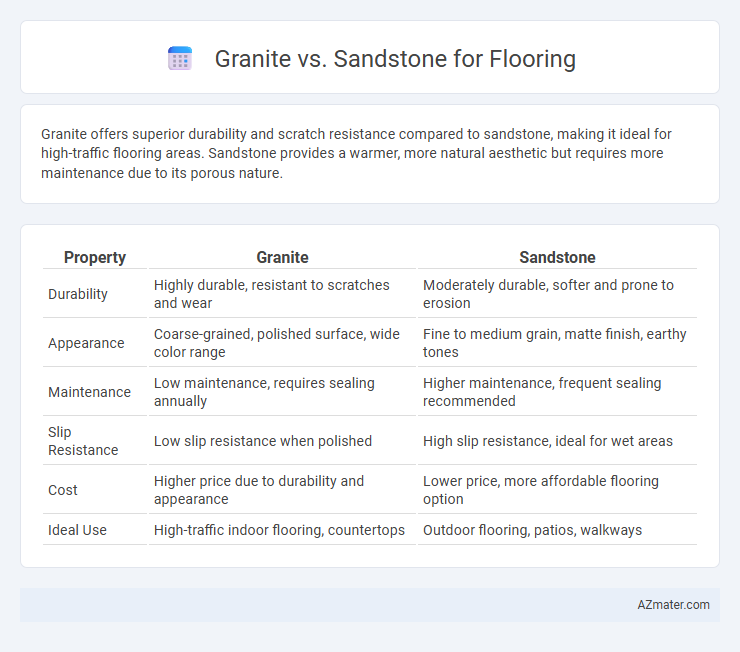Granite offers superior durability and scratch resistance compared to sandstone, making it ideal for high-traffic flooring areas. Sandstone provides a warmer, more natural aesthetic but requires more maintenance due to its porous nature.
Table of Comparison
| Property | Granite | Sandstone |
|---|---|---|
| Durability | Highly durable, resistant to scratches and wear | Moderately durable, softer and prone to erosion |
| Appearance | Coarse-grained, polished surface, wide color range | Fine to medium grain, matte finish, earthy tones |
| Maintenance | Low maintenance, requires sealing annually | Higher maintenance, frequent sealing recommended |
| Slip Resistance | Low slip resistance when polished | High slip resistance, ideal for wet areas |
| Cost | Higher price due to durability and appearance | Lower price, more affordable flooring option |
| Ideal Use | High-traffic indoor flooring, countertops | Outdoor flooring, patios, walkways |
Introduction: Granite vs Sandstone Flooring
Granite flooring offers exceptional durability and resistance to scratches and stains, making it ideal for high-traffic areas. Sandstone flooring provides a warm, natural aesthetic with a textured surface that enhances slip resistance but requires more maintenance to prevent staining. Choosing between granite and sandstone depends on balancing long-term durability with desired texture and appearance in interior or exterior applications.
Appearance and Aesthetic Differences
Granite flooring showcases a polished, glossy surface with a granular texture featuring speckles of black, white, gray, or pink, offering a luxurious and sophisticated aesthetic ideal for modern and upscale interiors. Sandstone flooring presents a matte, textured appearance with earthy tones ranging from beige to reddish hues, delivering a warm, rustic, and natural look suitable for traditional or outdoor spaces. The distinct visual contrast lies in granite's sleek, reflective quality versus sandstone's soft, organic finish, influencing the overall ambiance and style of flooring installations.
Durability and Strength Comparison
Granite flooring is highly durable and resistant to scratches, stains, and heavy foot traffic due to its dense, igneous rock composition, making it ideal for high-traffic areas. Sandstone, a sedimentary rock, is softer and more porous, which reduces its strength and makes it more susceptible to wear and damage over time. For long-lasting strength and superior durability, granite outperforms sandstone in flooring applications.
Maintenance and Cleaning Requirements
Granite flooring requires minimal maintenance due to its dense, non-porous surface, making it resistant to stains and easy to clean with simple soap and water. Sandstone, being more porous and softer, demands regular sealing and gentle cleaning to prevent staining and erosion from harsh chemicals or abrasive tools. Choosing granite reduces long-term upkeep and ensures a more durable, low-maintenance floor compared to the higher maintenance needs of sandstone.
Slip Resistance and Safety
Granite offers superior slip resistance for flooring due to its dense, coarse-grained texture, making it a safer option in wet or high-traffic areas. Sandstone, while aesthetically pleasing with its natural variation, tends to be more porous and smoother, increasing the risk of slips when wet. Choosing granite enhances safety by minimizing slip hazards, especially in environments where moisture is common.
Installation Process and Complexity
Granite flooring requires precise cutting and sealing techniques due to its hardness and density, often necessitating professional installation to avoid damage and ensure durability. Sandstone, being softer and more porous, allows for easier cutting and fitting but demands careful sealing to prevent moisture absorption and staining. Both materials involve different installation complexities, with granite posing more challenges in handling and cutting, while sandstone requires meticulous sealing and maintenance-focused application.
Cost Analysis: Granite vs Sandstone
Granite flooring typically costs between $40 and $75 per square foot, reflecting its durability and premium finish, while sandstone ranges from $7 to $15 per square foot, offering a more budget-friendly alternative. Installation expenses can also vary, with granite requiring skilled labor due to its hardness, increasing overall costs compared to sandstone's easier handling. Considering long-term maintenance, granite demands less upkeep and resists scratches and stains better than sandstone, which may incur additional expenses over time.
Environmental Impact and Sustainability
Granite flooring is highly durable and long-lasting, reducing the need for frequent replacement, which supports sustainability by minimizing resource consumption. Sandstone, being a natural sedimentary rock, has a lower carbon footprint in extraction and processing compared to granite but is less durable, potentially leading to higher maintenance and replacement rates. Both materials are natural, but granite's longevity often results in a lower environmental impact over the floor's lifecycle despite its higher initial energy use.
Best Applications for Each Stone
Granite's high durability, resistance to scratches, and low porosity make it ideal for high-traffic areas such as kitchens, hallways, and commercial spaces where longevity and maintenance are critical. Sandstone's natural slip resistance and warm, earthy tones are best suited for outdoor patios, garden paths, and low-traffic interiors, offering aesthetic appeal alongside functionality in humid or wet conditions. Choosing granite for heavy-use floors and sandstone for decorative or moderate-use surfaces ensures optimal performance and visual appeal.
Conclusion: Choosing the Right Stone for Your Floor
Granite offers exceptional durability, scratch resistance, and a polished finish, making it ideal for high-traffic areas and kitchens. Sandstone provides a unique, warm texture and natural slip resistance, suitable for patios or rustic indoor spaces but requires more maintenance due to its porosity. Selecting the right stone depends on balancing durability needs, aesthetic preferences, and maintenance commitments for your flooring project.

Infographic: Granite vs Sandstone for Flooring
 azmater.com
azmater.com